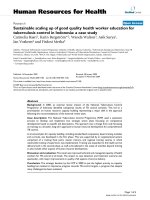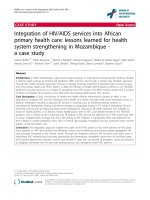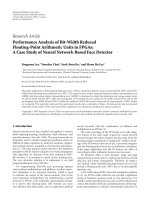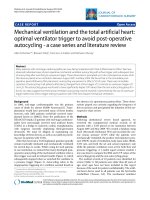Opportunities in the total support service sector as part of oursourcing industry in VietNam a case study of Sodexho
Bạn đang xem bản rút gọn của tài liệu. Xem và tải ngay bản đầy đủ của tài liệu tại đây (1.21 MB, 84 trang )
ĐẠI HỌC QUỐC GIA HÀ NỘI
TRƯỜNG ĐẠI HỌC KINH TẾ
NGUYỄN THỊ THANH SƠN
OPPORTUNITIES IN THE TOTAL SUPPORT
SERVICE SECTOR AS PART OF OUTSOURCING
INDUSTRY IN VIETNAM A CASE STUDY OF
SODEXHO
LUẬN VĂN THẠC SĨ QUẢN TRỊ KINH DOANH
NGƯỜI HƯỚNG DẪN KHOA HỌC: TS. Hoàng Anh Tuấn
Th.S Hà Nguyên
Hà Nội – 2007
ĐẠI HỌC QUỐC GIA HÀ NỘI
TRƯỜNG ĐẠI HỌC KINH TẾ
NGUYỄN THỊ THANH SƠN
OPPORTUNITIES IN THE TOTAL SUPPORT
SERVICE SECTOR AS PART OF OUTSOURCING
INDUSTRY IN VIETNAM A CASE STUDY OF SODEXHO
Chuyên ngành: Quản trị kinh doanh
Mã số: 60 34 05
LUẬN VĂN THẠC SĨ QUẢN TRỊ KINH DOANH
NGƯỜI HƯỚNG DẪN KHOA HỌC: TS. Hoàng Anh Tuấn
Th.S Hà Nguyên
Hà Nội – 2007
vi
TABLE OF CONTENTS
ABSTRACT i
TÓM TẮT iii
ACKNOWLEDGEMENTS v
TABLE OF CONTENTS vi
INTRODUCTION 1
I. BACKGROUND 1
II. RESEARCH OBJECTIVES 2
III. RESEARCH QUESTIONS 3
IV. METHODOLOGY 4
1. Paradigm: 4
2. Qualitative research: 5
3. Research methods 6
31. Case study: 6
3.2. Interview 7
4. Data collection 9
5. Analysis and interpretation 9
6. Research validity, reliability and ethics 10
V. OUTLINE 13
CHAPTER 1 14
LITERATURE REVIEW 14
1.1. OUTSOURCING INDUSTRY 14
vii
1.1.1. What is outsourcing? 14
1.1.2. Areas of outsourcing industry 24
1.1.3. Outsourcing: Pros and Cons 30
1.1.3.1. The benefits of Outsourcing: 31
1.1.3.2. Disadvantages of Outsourcing: 35
1.1.4. Why outsource? 37
1.2. THE TOTAL SUPPORT SERVICE INDUSTRY 40
CHAPTER 2 43
OUTSOURCING INDUSTRY IN VIETNAM 43
2.1. OVERVIEW OF OUTSOURCING INDUSTRY 43
2.2. FUTURE DEVELOPMENT 47
CHAPTER 3 49
THE TOTAL SUPPORT SERVICE INDUSTRY IN VIETNAM –
SODEXHO FIRM 51
3.1. THE TOTAL SUPPORT SERVICE INDUSTRY IN VIETNAM 51
3.1.1. Situation 49
3.1.2. Competition 56
3.2. SODEXHO FIRM 57
3.2.1. Introduction 57
3.2.2. Why mention to Sodexho? 58
3.3. FINDINGS about the total support service sectors when
conducting market research for Sodexho 60
viii
3.3.1. Catering service 63
3.3.2. Cleaning and laundry service 64
4.3.3. Maintenance service 64
CHAPTER 5 68
CONCLUSIONS AND RECOMMENDATION 68
1. CONCLUSIONS 68
2. RECOMMENDATIONS 69
2.1. For successful Outsourcing strategy 69
2.1.1. Try to limit disadvantages of outsourcing by: 69
2.1.2. Choose the right outsourcing partner 70
2.1.3. Refer to outsourcing checklist for the real reason
why you outsource 71
2.1.4. Do not rely exclusively on only one provider without considering
the situation of the market and the capability of the provider. 72
2.1.5. “Businesses must constantly assess the effectiveness of outsourcing"
and "should not be seen as a short-term solution”. 73
2.2. For the total support service sector and the case of Sodexho 74
2.2.1. For service providers 74
2.2.2. For users (customers) 76
References 78
Appendices 81
Exhibit A: List of main catering companies 81
ix
Exhibit B: List of cleaning and laundry companies 83
List of interviewees 85
1
INTRODUCTION
I. BACKGROUND
In order to remain competitive in today's global marketplace, organizations are
turning their focus towards their core competencies and looking to outsource
functions in which they lack expertise to maintain effective cost structures and to
improve their bottom lines (profit).
“Some forward-thinking executives are beginning to use outsourcing as a change-
management tool to drive major, enterprise-level transformation.‖
(Martha Craumer)
This is an idea of a business and marketing writer at Harvard Business School in
US. He considered outsourcing as a tool of change-management that helps
companies to transform themselves to compete successfully with other rivals. In the
context of today’s environment where competition is becoming tougher and
tougher, it is essential that organizations should realize whether they should do
everything by themselves or they should hire outsiders to carry some non core
activities on behalf of them. By doing so, they can focus on developing their core
competencies which are very important to compete with their competitors or just to
gain more profits.
As a leader or manager of organization, it is better for you to know about the
current trend that companies will outsource some of their non-core activities to
service providers who are very professional. However, it is also necessary for
leaders and managers to know about pros and cons of outsourcing activities so that
2
they can make right decisions for their organizations. In simple word, outsourcing
or not depends on analysis of its benefits and disadvantages.
Thus, within scope of this thesis, I would like to study about outsourcing industry in
general and the total support service sector in Vietnam in particular. As a leader or
manager of the company, it is essential to know about this trend, and the benefits
and the downside of outsourcing as well as opportunities in the total support service
sector.
With the case study of the total support service industry with typical company
Sodexho, a French firm providing support services, the thesis would like to deliver
how a world wide company response to opportunities of this sector in Vietnam
through market research process this company conduct in Vietnam. This market
research also provides realizable information to understand about this sector in
Vietnam.
II. RESEARCH OBJECTIVES
Firstly, give an overview of outsourcing industry as a current trend of today’s
business
Secondly, analyze the benefits and downside of outsourcing industry, which
will help firms to make business decisions relating to outsourcing.
Thirdly, examine the total support service sector in Vietnam with a case
study of Sodexho
Fourthly, explore opportunities in the total support service industry in
Vietnam.
3
Based on these information, leaders or managers of any organizations can make
decisions effectively whether they should take opportunities of outsourcing industry
as a outsourcer or service providers or whether they should outsource some work to
outsiders or they should keep it in-house.
III. RESEARCH QUESTIONS
This thesis aims to answer the following questions:
What is outsourcing?
What are the benefits/ threats of outsourcing?
What should be outsourced?
What is current situation of outsourcing industry in general and the total
support service in particular in Vietnam?
How outsourcers and service providers think about opportunities of this
industry in Vietnam?
What kind of lessons can be drawn from this study would be useful to
leaders or managers of company?
IV. METHODOLOGY
Methodology usually refers to the general approaches to research while method
refers to techniques for gathering evidence. Therefore, methodology is a theory and
analysis of how research is done or should proceed. It includes research paradigm,
what kind of research (qualitative or quantitative), what methods to be used, how to
4
collect data and analyze data, how to ensure the validity and reliability of the
research, what kind of ethics issues may happen.
1. Paradigm:
Paradigm is considered as a basic set of beliefs that guide action. It defines the
world-view of the researcher (Guba, 1990, cited in Denzin et at., 1994). A paradigm
encompasses three elements:
Epistemology: asks, how do we know the world? What is the relationship
between inquirer and the known?
Ontology: raises basic questions about the nature of reality.
Methodology: focuses on how we gain knowledge about the world
Research is a process of structured inquiry that can be undertaken via different
approaches (Burn, 1997). There are three common research paradigms, including
positivism, constructivism and critical theory.
Constructivism paradigm will be used in this research because the aim of this
research is to understand the issue from multiple perspectives and describe it using
qualitative approaches such as interviewing. Constructivism aim for a depth
understanding about outsourcing industry in Vietnam by consulting with different
people and understanding their perceptions rather than explaining a hypothesized
phenomenon (positivism) or creating social changes (critical theory). This paradigm
helps us discover what we want to know through interactions with research
participants
2. Qualitative research:
5
With constructivist approach, qualitative methods will be used in the research. This
methodology aims to understand and discover the nature and essences of research
problems (Merriam, 1998). Qualitative is multi-method in focus, involving an
interpretive, naturalistic approach to its subject matter (Brewer & Hunter, 1989,
cited in Denzin et al., 1994). It involves the studied use and collection of a variety
of empirical materials such as case study, personal experience, interview,
observation, etc (Denzin et al., 1994).
For this research, qualitative approach is suitable because the researcher tries to
explore one phenomenon in business, it is outsourcing in general and total support
service in particular. This issue will be examined from many aspects, including its
benefits, its pros and cons, ect.
3. Research methods
Case study:
A case study is a study in which the researcher explores a single entity or
phenomenon (the case) bounded by time and activity (a program, event, process, a
social group, etc.) and collect detailed information by using variety of data
collection procedures during a period of time (Merriam, 1998: 21).
A case study can be qualitative research or quantitative research. Stake (1994)
clarifies case study into 3 types.
Intrinsic case study is the study undertaken when one wants better
understanding of this particular case.
6
Instrumental case study: a particular case is examined to provide insight into
an issue or refinement of theory. The case plays a supportive role, facilitating
our understanding of something else. It is often looked in depth, its contexts
scrutinized, its ordinary activities detailed.
Collective case study: means study a number of cases jointly in order to
inquire into the phenomenon, population, or general condition.
This research chooses the total support service sector with Sodexho firm as an
instrumental case study to examine the opportunities of total support service
industry in Vietnam. The researcher use the process of conducting market research
of the company to examines carefully the total support service sector in Vietnam.
Through this case, the researcher also wants to send the message to the leaders and
managers about one possibility to improve its competitiveness by finding ways to
improve its efficiency.
For case study approach, followings are the main methods/ techniques used:
In-depth interview
Document review or analysis
Questionnaire and survey
With this case study, the researcher will conduct interview with managers of
Sodexho and its potential customers, review document related to the issue, which is
available for public. The researcher also use questionnaire to further explore the
opinions of customers about outsourcing activities.
Interview
7
The interview is the favorite methodological tool of the qualitative researcher. It is
defined as a conversation, the art of asking questions and listening (Denzin et al.,
1994: 353). Interview can be in one of three forms: structured, unstructured, and
semi-structure
(Fontana & Frey, cited in Denzin et al., 1994).
Structured interviewing: refers to a situation in which an interviewer asks
each respondent a series of pre-established questions with a limited set of
response categories (Fontana & Frey, cited in Denzin et al., 1994: 363).
Unstructured interviewing: refers to interview without any pre-established
questions. It is very flexible way to conduct an interview. The traditional
type of unstructured interview is the in-depth interview.
Group interview refers to interview of several individuals simultaneously in formal
or informal settings (Frey & Fontana, 1994). This type of interview is very common
in marketing research where ―focus group‖ technique is widely used.
The researcher will use interview method to analyze the case study as well as to
gain more in-depth knowledge about this issue by consulting with executives from
different companies.
In-depth interview:
As in-depth interview will be intensively used in this research, it is necessary to
understand more about this method.
Taylor and Bogdan (1984, cited in Minichiello et al., 1990) define in-depth
interview ―repeated face to face encounters between the researcher and informants
8
directed toward understanding informant’s perspectives on their lives, experiences
or situations as expressed in their own words‖. In-depth interview can be structured
or unstructured.
Why use in-depth in this research? Because it is the most appropriate qualitative
research method to understand the insights of outsourcing from people who have
experience and knowledge of the field. In other words, in-depth interview in this
research is aim to gain access to, and an understanding of, activities and events
which can not be observed directly by researcher.
4. Data collection
According to Patton (2002: 4), there are three kinds of qualitative data:
Interview is conduct to collect in-depth responses about people’s
experiences, perceptions, opinions, feelings, and knowledge.
Observation refers to fieldwork descriptions of activities, actions,
conversations, interpersonal interactions, organizational or community
processes, or any other aspect of observable human experience.
Documents refers to written materials and other documents from
organizational, clinical, or program records, memoranda and correspondence,
official publications and reports, personal diaries, letters, etc.
Data will be collected mainly through interviews with executives of Sodexho and
their potential customers as well as executives from different companies in the
sector. The researcher interviewed business development manager of Sodexho,
9
marketing manager of Somerset, CEO of Minh Nam catering Service Co.,Ltd, CEO
of Southern Catering Co.,Ltd, etc.
5. Analysis and interpretation
In this research, three kinds of qualitative data will be analyzed and interpreted.
Interview will be recorded, transcripted and translated into English (if
necessary). All information will be arranged by issues later.
Documents will be arranged and classified by issues.
Writing the report
6. Research validity, reliability and ethics
Research validity
Merriam (1998) classifies validity into internal validity and external validity.
Internal validity is about how research findings match reality. He offers six basis
strategies to enhance internal validity. They are triangulation (multiple
investigators, multiple sources of data, or multiple methods), member checks, long-
term observation, peer examination (asking colleagues to comment on the findings
as they emerge), participatory or collaborative modes of research, researcher’s
biases.
This research will use triangulation and peer examination as the ways to increase
internal validity for the research. Multiple sources of data (primary and secondary
data) will be collected. During the research, the researcher will ask comments from
other students, people in business sector.
10
External validity is concerned with the extent to which the findings of one study can
be applied to other situations (Merriam, 1998). Three strategies can be used,
including
Rich, thick description: providing enough description so that readers will be
able to determine how closely their situations match the research situation.
Typicality or modal category: describing how typical the research is
compared with others in the same class.
Multi-site designs: using several sites, cases, situations, especially those that
maximize diversity in the phenomenon of interest.
The researcher will use rich, thick description and multi-site designs to improve
external validity of the research.
Reliability
Reliability refers to the extent to which research findings can be replicated. In other
words, if the study is repeated will it yield the same results? (Merriam, 1998)
In qualitative research, the question is not whether findings will be found again but
whether the results are consistent with the data collected. Some techniques can be
used to ensure that results are dependable:
The investigator’s position: the researcher should explain the assumptions
and theory behind the study.
Triangulation: in terms of using multiple methods of data collection and
analysis.
Audit trail: independent judges can authenticate the findings of a study.
11
In this research, triangulation will be the main technique to check the validity of the
study. Different methods of collecting data (interview, documents, observation) and
different ways to analyze data will be used to improve reliability of the findings.
Ethics
Ethics concern about whether the investigation is conducted in an ethical manner.
Merriam (1998) claims that ethics issues can exist when the researcher collect data
and analyze data, even disseminate findings. It is important to minimize the effect
of researcher’s theoretical and political bias.
Fontana and Frey (1994) assert that three ethical principles should be paid attention
to in qualitative research:
Informed consent: the research participants should be informed carefully and
truthfully about the research purposes.
Right to privacy: protecting the identity of research participants
Protection from harm: physical, emotional or any other kinds.
These principles will be employed when researchers collect data, analyze data and
disseminate findings.
In this research, the researcher will use case study and different method to collect,
analyze data, so it is important for the researcher to follow ethics guide from
university to ensure that the study is conducted in ethical manner.
V. OUTLINE
There are three chapters in my thesis:
Chapter 1: Literature review
12
Chapter 2: Overview of Outsourcing industry in Vietnam
Chapter 3: The Total support service sector in Vietnam - A case study of
Sodexho firm.
13
CHAPTER 1
LITERATURE REVIEW
1.1. OUTSOURCING INDUSTRY
1.1.1. What is outsourcing?
Outsourcing is one of biggest trends in business today. According to Mark, 90% of
all US businesses outsource some work. Regarding to the concept of outsourcing,
many scholars as well as economists agree to some main points as follows:
―Outsourcing (or contracting out) is often defined as the delegation of non-core
operations or jobs from internal production to an external entity (such as a
subcontractor) that specializes in that operation. Outsourcing is a business decision
that is often made to focus on core competences. A subset of the term (offshoring)
also implies transferring jobs to another country, either by hiring local
subcontractors or building a facility in an area where labor is cheap. It became a
popular buzzword in business and management in the 1990s.‖
1
This definition
refers to some key points:
Outsourcing is the delegation which means that one company called prime
contractor or host company will assign subcontractor who is sent and
empowered to act for the company in some limited activities.
The delegation should be for non-core operations only which can be
understood that the company will rely on outsiders for some work that they
1
Definition from website of Wikipedia, the free encyclopedia ()
14
think is not important to the company but still necessary such as catering
service or maintainance service.
Outsorcing is business decision which means that the company makes this
decision based on analyse pros and cons of this activity and find out the
benefits as well as disadvanges of this decision and its impacts on the
operation of the company. The bottom line of this decision is whether the
running of the company will be more efficient or not.
Offshoring: In many case, offshoring is refered to one common form of
outsourcing. Offshoring can be defined as relocation of business processes
(including production/manufacturing) to a lower cost location, usually
overseas. Offshoring can be seen in the context of either production
offshoring or services offshoring. After its accession to the WTO, China
emerged as a prominent destination for production offshoring. After
technical progress in telecommunications improved the possibilities of trade
in services, India is a country leading in this domain.
Another definitions: In the book ―Manging the outsourcing relationship‖,
outsourcing is defined as the contracting of any service or activity to a third party
organization (Mc.Huht, Merli&Wheeler, 1995). It is oftern describe as a form of
vertical integration.
―Outsourcing is defined as the management and/or day-to-day execution of an
entire business function by a third party service provider‖. In this definition, one
part of the management and/or execution of business activities or operations is
15
carried by outside service providers who are specialized in some activities so that
they can provide a better services with competitive prices. This leads to more
benefits for the company if they do not do those works by themselves.
Outsourcing and out-tasking involve transferring a significant amount of
management control to the supplier. Buying products from another entity is not
outsourcing or out-tasking, but merely a vendor relationship. Likewise, buying
services from a provider is not necessarily outsourcing or out-tasking. Outsourcing
always involves a considerable degree of two-way information exchange, co-
ordination, and trust.
Organizations that deliver such services feel that outsourcing requires the turning
over of management responsibility for running a segment of business. In theory, this
business segment should not be mission-critical, but practice often dictates
otherwise. Many companies look to employ expert organizations in the areas
targeted for outsourcing. Many companies also outsource customer support and call
center functions, manufacturing and engineering. Outsourcing business is
characterized by expertise not inherent to the core of the client organization.
A related term is out-tasking: turning over a narrowly-defined segment of business
to another business, typically on an annual contract, or sometimes a shorter one.
This usually involves continued direct or indirect management and decision-making
by the client of the out-tasking business.
16
"Outsourcing is just a new way of doing international trade," said N. Gregory
Mankiw, chairman of Bush's Council of Economic Advisors
2
. This definition
considers outsourcing from aspect of trading among nations where countries bring
into play the nation’s advantages over others. For this definition, the author
memtioned comparative advantage theory and absolute advantage theory in terms of
outsourcing from one country to another country. Just come back to key points of
these theories before considering in aspect of outsourcing.
The theory of absolute advantage was first explained by the Scottish economist
Adam Smith in 1776. He argued that a country has an absolute advantage in the
production of a good when it can produce more of that good with a given amount of
resources than another country. It was developed later to the comparative advantage
theory.
The theory of comparative advantage explains why it can be beneficial for two
countries to trade, even though one of them may be able to produce every kind of
item more cheaply than the other. It was first described by Robert Torrens in 1815
in an essay on the corn trade. He concluded that it was to England's advantage to
trade various goods with Poland in return for corn, even though it might be possible
to produce that corn more cheaply in England than Poland. However, it is usually
attributed to David Ricardo who explained it clearly in his 1817 book The
Principles of Political Economy and Taxation in an example involving England and
Portugal. After that, this theory was further developed by Heckscher, Ohlin and
2
In the article “Bush economic report praises 'outsourcing' jobs” by By Warren Vieth and Edwin
Chen, Los Angeles Times, 10
th
Feb 2004
17
Sumuelson who argued that countries have different factor endowments of labour,
land and capital inputs. Countries will specialize in and export those products which
use intensively the factors of production which they are most endowed.
Outsourcing in broad terms is a transfer of some business functions or
components of business processes to an outside contractor
3
. To remain
competitive, many companies consider outsourcing as a way to reduce costs,
increase efficiencies, and refocus on critical resources.
Outsourcing is not just related to the services sector. A lot of manufacturing of
products is also outsourced to countries like China and Taiwan. Consumer products
including clothes and computer hardware are manufactured in these countries
thanks to cheap labor, which leads to cheaper prices in the consuming nations
Outsourcing is increasingly being applied, not only to manufacturing activities, but
to traditional in-house administrative and management functions, including data
processing and information technology operations, human resource management
services, accounting functions, internal audit and marketing (Chalos, 1995).
Outsourcing may be undertaken to varying degrees. In many situations, the
relationship between an organization and an outsourcer resembles a partnership,
rather than customer – supplier relationship (Mc.Hugh et al., 1995).
From above mentioned definitions, some terminologies are needed to clarified their
meanings
Core competencies: that should be kept in-house rather than outsource
3
Outsourcing Toolkit
18
A company's core competency is the one thing that it can do better than its
competitors. A core competency can be anything from product development to
employee dedication. Modern business theories suggest that most activities that are
not part of a company's core competency should be outsourced. In simple words,
core competencies are something that bring some advantages to the development of
the company and help the company to compete sucessfully with its competitors.
And the competency of different company is not the same, even they are operating
in the same industry because a core competency yeilds a advantage to the company.
If a core competency yields a long term advantage to the company, it is said to be a
sustainable competitive advantage which makes it superior than its rivals
The concept of core competencies was developed in the management field. C.K.
Prahalad and Gary Hamel introduced the concept in a 1990 Harvard Business
Review article. They wrote that a core competency is "an area of specialized
expertise that is the result of harmonizing complex streams of technology and work
activity."
As an example they gave Honda's expertise in engines. Honda was able to exploit
this core competency to develop a variety of quality products from lawn mowers
and snow blowers to trucks and automobiles. To take an example from the
automotive industry, it has been claimed that Volvo’s core competence is safety.
According to Prahalad and Hamel a core competence has three characteristics:
it provides potential access to a wide variety of markets,
it increases perceived customer benefits and
19
it is hard for competitors to imitate.
Ever since Prahalad and Hamel introduced the term in the 1990’s many researchers
have tried to highlight and further illuminate the meaning of core competence.
According to Leonard-Barton, D. ―Capabilities are considered core if they
differentiate a company strategically‖. On the other hand Galunic and Rodan (1998)
argue that ―a core competence differentiates not only between firms but also inside
a firm it differentiates amongst several competencies. In other words, a core
competency guides a firm recombining its competencies in response to demands
from the environment‖.
It is important to distinguish between individual competencies or capabilities and
core competencies. Individual capabilities stand alone and are generally considered
in isolation. Gallon, Stillman, and Coates (1995) made it explicit that core
competencies are more than the traits of individuals. They defined core
competencies as "aggregates of capabilities, where synergy is created that has
sustainable value and broad applicability." That synergy needs to be sustained in the
face of potential competition and, as in the case of engines, must not be specific to
one product or market. So according to this definition, core competencies are
harmonized, intentional constructions.
Coyne, Hall, and Clifford (1997) proposed that "a core competence is a combination
of complementary skills and knowledge bases embedded in a group or team that
results in the ability to execute one or more critical processes to a world class
standard." Two ideas are especially important here. The skills or knowledge must be









